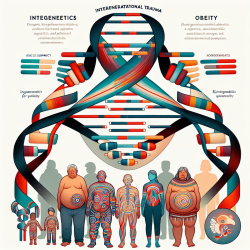Unlocking the Potential of Cumulative Risk Assessment for Better Child Outcomes
As a speech-language pathologist, the quest for improving child outcomes is a continuous journey. The recent research on cumulative risk assessment (CRA) provides a novel approach that can be integrated into our practice to enhance the effectiveness of interventions. The study, "Community, State, and Federal Approaches to Cumulative Risk Assessment: Challenges and Opportunities for Integration," sheds light on how a consistent CRA methodology can be pivotal in addressing the multifaceted challenges faced by children, especially those in vulnerable communities.
Understanding Cumulative Risk Assessment
CRA is a comprehensive method that evaluates the combined risks from multiple agents or stressors, both chemical and non-chemical, on health and the environment. Unlike conventional risk assessments that focus on single stressors, CRA considers the synergistic effects of multiple stressors, stakeholder participation, and the roles of susceptibility and vulnerability. This holistic approach is particularly relevant in speech-language pathology, where environmental and social factors can significantly impact child development.
Key Takeaways from the Research
- Integration of Multiple Stressors: CRA emphasizes the importance of considering a wide range of stressors, including environmental pollutants and social factors, which can affect a child's development and learning abilities.
- Stakeholder Engagement: The research highlights the need for involving stakeholders, including families and communities, in the assessment process to ensure that interventions are culturally sensitive and locally relevant.
- Risk Management and Communication: Effective risk communication and management are crucial for implementing successful interventions. This involves transparent dialogue with all stakeholders to develop feasible solutions.
Implementing CRA in Speech-Language Pathology
For practitioners in the field of speech-language pathology, integrating CRA into practice involves several steps:
- Identify and Rank Stressors: Assess the various environmental and social stressors affecting the child. This could include factors like exposure to pollutants, socioeconomic status, and access to resources.
- Engage Families and Communities: Work closely with families and communities to understand their perspectives and involve them in the decision-making process. This can lead to more tailored and effective interventions.
- Develop and Prioritize Solutions: Based on the identified stressors, develop interventions that address the most significant risks. Prioritize solutions that are feasible and have the potential for the greatest impact.
Encouraging Further Research
The integration of CRA into speech-language pathology is still in its nascent stages. Practitioners are encouraged to delve deeper into the research and explore how these methodologies can be adapted to their specific contexts. By doing so, we can ensure that our interventions are not only data-driven but also holistic and sustainable.
To read the original research paper, please follow this link: Community, State, and Federal Approaches to Cumulative Risk Assessment: Challenges and Opportunities for Integration.










